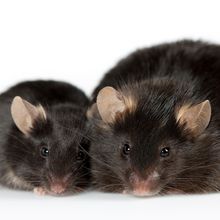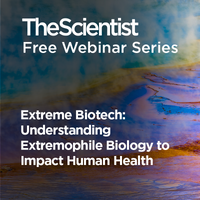Login
Subscribeimmunology, microbiology

What Happens When You Catch More than One Virus?
Alejandra Manjarrez, PhD | Dec 7, 2022 | 8 min read
The “tripledemic” shines a spotlight on viral interference, in which one infection can block another.

Blood Thinner Ineffective for COVID-19 Patients: Study
Dan Robitzski | Nov 28, 2022 | 2 min read
A clinical trial finds that the anticoagulant apixaban, which has been prescribed to help COVID-19 patients recover, is ineffective and in rare instances dangerous.

Securing the Antibody Supply Chain through Recombinant Antibody Technology: A COVID-19 Case Study
The Scientist Creative Services Team in collaboration with Sartorius Corporation | 1 min read
Nicholas Hutchings will discuss how recombinant antibody technology can speed up the response to a pandemic.

Obesity Protects Against Genital Herpes in Mice, Study Finds
Katherine Irving | Nov 11, 2022 | 3 min read
A high-fat diet induced changes to the animals’ vaginal microbiomes that boosted survival after exposure to the virus.

Flu/RSV Coinfection Produces Hybrid Virus that Evades Immune Defenses
Catherine Offord | Oct 25, 2022 | 2 min read
When fused to RSV, influenza A virus is better able to escape antibodies that usually neutralize it, an in vitro study finds.

Thwarting a Pandemic: COVID-19 Vaccine Strategies
The Scientist | 1 min read
Download this poster to learn about promising vaccine candidates for COVID-19!

US Agency to Look into Project on Modified Coronavirus
Catherine Offord | Oct 18, 2022 | 3 min read
The National Institute of Allergy and Infectious Diseases was not aware that the work involved a chimeric strain of SARS-CoV-2, STAT reports.

Oxford-AstraZeneca Nasal COVID-19 Vaccine Falters in Clinical Trial
Dan Robitzski | Oct 11, 2022 | 2 min read
Researchers say they’re abandoning the project in its current form—one of several that aims to induce what’s known as mucosal immunity against SARS-CoV-2.

Extreme Biotech: Understanding Extremophile Biology to Impact Human Health
The Scientist | 1 min read
Jaclyn Winter and Shiladitya DasSarma will discuss how they harness the unique biology of extremophiles for the discovery and development of new therapeutics.

Vitamin D Likely Doesn’t Prevent COVID-19, Studies Find
Dan Robitzski | Sep 9, 2022 | 2 min read
The results from two large clinical trials don't support the idea that supplements of the vitamin bolster immune defenses against SARS-CoV-2.

How a Specific Gut Bacterium May Cause Type 1 Diabetes
Dan Robitzski | Aug 25, 2022 | 5 min read
A bacterium that produces an insulin-like peptide can give mice type 1 diabetes, and infection with the microbe seems to predict the onset of the disease in humans, a study finds.

Prokaryotes Are Capable of Learning to Recognize Phages
Patience Asanga | Aug 17, 2022 | 3 min read
Immune defense genes in bacteria and archaea can identify viral proteins, a study finds, revealing similarities between the immune systems of prokaryotic and eukaryotic organisms.

How COVID-19 Affects Pregnancy
Amanda Heidt | Aug 16, 2022 | 10 min read
Evidence thus far shows that pregnant people infected with SARS-CoV-2 are at higher risk for severe disease and death, as well as complications in their pregnancies.

Can Taking a Test Now Tell You if You’ve Already Had COVID-19?
Natalia Mesa, PhD | Aug 8, 2022 | 4 min read
The Scientist asks Brigham and Women’s Hospital infectious disease specialist Lindsey Baden about testing for prior infections.

Through the Looking Glass: Aging, Inflammation, and Gut Rejuvenation
Iris Kulbatski, PhD | Aug 8, 2022 | 4 min read
Renewing the aging gut microbiome holds promise for preventing inflammatory brain and eye degeneration.

Mapping the Neighborhoods of the Gut Microbiome
Abby Olena, PhD | Jul 1, 2022 | 7 min read
Researchers are going beyond fecal samples to understand how the patterns of commensal microbes in the gastrointestinal tract influence development and health.

HHMI to Award More than $1 Billion to Promote Equity in Research
Andy Carstens | May 26, 2022 | 2 min read
A new program will provide 150 early-career scientists committed to advancing diversity, inclusion, and equity up to $8.6 million each.

Diabetes Marker Linked to COVID-19 Severity in Mice
Alejandra Manjarrez, PhD | May 16, 2022 | 3 min read
A sugar that’s less abundant in the blood of people with diabetes binds to SARS-CoV-2’s spike protein and disrupts the virus’s ability to fuse with cells.

New Mechanism for Virus-Triggered Autoimmunity Uncovered
Sophie Fessl, PhD | Mar 11, 2022 | 4 min read
Roseolovirus infection disrupts how the body trains immune cells not to attack it, a mouse study shows.

Studies Identify Risk Factors for Long COVID
Natalia Mesa, PhD | Jan 26, 2022 | 4 min read
Two recent papers provide insight into possible risk factors for developing the chronic condition, including autoantibodies and diabetes.